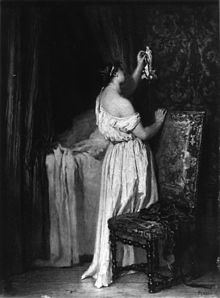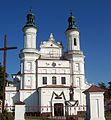Rosary devotions and spirituality
The rosary is one of the most notable features of popular Catholic spirituality.[1] According to Pope John Paul II, rosary devotions are "among the finest and most praiseworthy traditions of Christian contemplation."[2] From its origins in the twelfth century the rosary has been seen as a meditation on the life of Christ, and it is as such that many popes have approved of and encouraged its recitation.
Use of repetitive prayer formulas goes far back in Christian history, and how these passed into the rosary tradition is not clear. It is clear that the 150 beads (Hail Marys) originated from the 150 Psalms prayed from the Hebrew Psalter. The rosary was a way for the ordinary faithful to simulate the meditation of the monks from the hand-printed Psalter. The second half of the Hail Mary, the petition to Mary, appeared for the first time in the catechism of Peter Canisius in 1555 in the Counter-Reformation period, in reaction against Protestant criticism of some Catholic beliefs.[3][4]
Following the establishment of the first
Origins
There are differing views on the origin of the rosary, with some traditions attributing it to Dominic who integrated it into Dominican devotion, but evidence shows its existence prior to his time, and a gradual development over centuries of practice.[5][6]
| Part of a series on the |
| Rosary of the Catholic Church |
|---|
 |
| Overview |
| Prayers and promises |
|
| Writings |
| People and societies |
|
|
Catholicism portal |
The practice of

By the 1500s the practice of meditation during the rosary had spread across Europe. Bartolomeo Scalvo's Meditationi del Rosario della Gloriosa Maria Virgine (i.e. Meditations on the Rosary of the Glorious Virgin Mary) printed in 1569 for the rosary confraternity of Milan provided an individual meditation to accompany each bead or prayer.[7]
Alanus de Rupe encouraged the rosary to be prayed in front of an image of
During the 16th century, the use of images as a form of religious instruction and indoctrination via silent preaching (muta predicatio) was promoted by Gabriele Paleotti in his "Discourse on Sacred and Profane Images."[9] As the use of devotional images came to be seen as the "literature of the layman", Paleotti's goal of the transformation of Christian life through the use of sacred images fostered and promoted Marian devotions including the Rosary.[10]
By the 17th century, the 15 wood cut images of the picture rosary had become very popular and rosary books began to use them across Europe. In contrast to written rosary meditations, the picture texts changed little and the same set of images appeared in woodcuts, engravings, and devotional panels for over a hundred and fifty years.[8]
Meditation and contemplation

The word meditation comes from the Latin word meditari which means to concentrate.
By meditation I mean prolonged reasoning with the understanding, in this way. We begin by thinking of the favor which God bestowed upon us by giving us His only Son; and we do not stop there but proceed to consider the mysteries of His whole glorious life.
This perspective can be viewed as the basis of most scriptural rosary meditations.[14] Scriptural meditations on the rosary build on the Christian tradition of Lectio Divina (divine reading) as a way of using the Gospel to start a conversation between the soul and Christ.
Christian meditation is differentiated from contemplation which involves a higher level of focus and detachment from the surroundings and environment.[15] The word contemplation (coming from the Latin root templum, i.e. to cut or divide) means to separate oneself from the environment. John of the Cross called contemplation "silent love" and viewed it as an intimate union with God.[16] Contemplation with the rosary is the next step beyond scriptural meditation. This does not mean that the Gospel is ignored during contemplation, but that the focus moves toward the love of God.[17]
In his 2002 encyclical Rosarium Virginis Mariae, Pope John Paul II emphasized that the final goal of Christian life is to be transformed, or "transfigured", into Christ, and the rosary helps believers come closer to Christ by contemplating Christ. He characterized the contemplative aspects of the rosary as follow: "To recite the rosary is nothing other than to contemplate with Mary the face of Christ."[18] And quoting Pope Paul VI he reiterated the importance of contemplation, stating that without contemplation, the rosary is "a body without soul."[19]
The rosary may be prayed anywhere, but as in many other devotions its recitation often involves some sacred space or object, such as an image or statue of the Virgin Mary.[20] Anyone can begin to pray the rosary, but repeated recitations over a period of time result in the acquisition of skills for meditation and contemplation.[21]
Teachings of the saints

In the sixteenth century,
In the eighteenth century,
Padre Pio was a firm believer in meditation in conjunction with the rosary and said: "Love the Madonna and pray the rosary, for her rosary is the weapon against the evils of the world today. ...The person who meditates and turns his mind to God, who is the mirror of his soul, seeks to know his faults, tries to correct them, moderates his impulses, and puts his conscience in order."[27]
Papal views
In 1569
Pope
And truly, from the frequent meditation on the Mysteries, the soul little by little and imperceptibly draws and absorbs the virtues they contain, and is wondrously enkindled with a longing for things immortal, and becomes strongly and easily impelled to follow the path which Christ Himself and His Mother have followed.[33]
The popes of the 19th and 20th centuries up to
| Part of a series on the |
| Mariology of the Catholic Church |
|---|
 |
|
Catholicism portal |
Pope John Paul II built on the Christocentric theme of Pope Paul VI,[35] stating: "The rosary, though clearly Marian in character, is at heart a Christocentric prayer. In the sobriety of its elements, it has all the depth of the Gospel message in its entirety, of which it can be said to be a compendium."[36]
He further emphasized the contemplative nature of the rosary and stated that: "The rosary belongs among the finest and most praiseworthy traditions of Christian contemplation."[2]
Apparitions
References to the rosary have been part of a number of reported
Bernadette Soubirous stated that in the first apparition of Our Lady of Lourdes in 1858, the Virgin Mary had a rosary with her and that Bernadette prayed the rosary in her presence then and during subsequent apparitions.[39] The Rosary Basilica was built at that site in Lourdes in 1899.
The rosary was prominently featured in the apparitions of
In January 1933 an eleven-year-old peasant girl called
In the reported messages of
Gallery of art and architecture
-
Antonello da Messina, 15th century
-
Guido Reni, c. 1596
-
Lorenzo Lotto, 1539
-
Rosary Madonna (detail) Josef Mersa ca 1905
-
Holy Rosary Church,Wysokie Kolo, Poland
-
Bangkok, Thailand
-
Our Lady of the Rosary, Merelbeke, Belgium
See also
Notes
- ISBN 0-631-21281-7p. 16
- ^ a b Pope John Paul II, Rosarium Virginis Mariae § 5, Vatican
- ^ Petrus Canisius, CATECHISMI Latini et Germanici, I, ( ed Friedrich Streicher, S P C CATECHISMI Latini et Germanici, I, Roma, Munich, 1933, I, 12
- ISBN 0-8294-1350-2p. 73
- ISBN 0-89870-518-5
- ^ Thurston, Herbert, and Andrew Shipman. "The Rosary." The Catholic Encyclopedia. Vol. 13. New York: Robert Appleton Company, 1912. 7 Oct. 2014
- ISBN 0-7546-5121-5
- ^ a b Winston-Allen 1997, pp. 32–34.
- ISBN 0-8147-9591-9
- ISBN 0-7914-2894-X
- The Walters Art Museum.
- ISBN 81-7109-429-5
- ISBN 0-8091-2254-5page 147
- ISBN 0-85244-403-6
- ^ Poulain, Augustin. "Contemplation." The Catholic Encyclopedia. Vol. 4. New York: Robert Appleton Company, 1908. 7 Oct. 2014
- ISBN 0-88489-832-6
- ISBN 0-8294-2351-6
- ^ Rosarium Virginis Mariae, § 3
- ^ Madore 2004, pp. 18–19.
- ISBN 0-7102-1313-1
- ISBN 0-7425-5084-2
- ^ Braunsberger, Otto. "Blessed Peter Canisius." The Catholic Encyclopedia. Vol. 11. New York: Robert Appleton Company, 1911. 7 Oct. 2014
- ISBN 0-87973-347-0
- ISBN 1-57918-355-7
- ISBN 978-0-89555-056-9,
- ISBN 0-7648-0664-5
- ISBN 0-8294-2024-X
- ISBN 0-8294-1489-4
- ^ Cizik, Ladis J. "Our Lady and Islam: Heaven's Peace Plan", EWTN
- ISBN 1-58617-030-9
- ^ Remigius Baumer, 1988, Marienlexikon, St. Ottilien, pp.41
- ^ Stravinskas 2000, p. 135.
- ^ Pope Pius XII. Ingruentium Malorum, Vatican
- ^ Pope Paul VI, Marialis Cultus § 46
- ^ Fahlbusch & Bromiley 2005, p. 757.
- ^ Rosarium Virginis Mariae § 1
- ISBN 1-891280-10-4
- ISBN 0-86012-320-0
- ISBN 1-58617-116-X
- ^ de Marchi, John. The True Story of Fatima, 1952, EWTN
- ISBN 0-911218-10-6
- ISBN 1-74059-682-X
- ^ Scaperlanda 2002, p. 124.
- ISBN 0-87973-910-X
- ^ van Houtryve, La Vierge des Pauvres, Banneux, 1947
- ISBN 978-1-59276-441-9
- ISBN 0-87973-669-0page 124
- ^ "Apparitions of the Blessed Virgin Mary in Akita, Japan to Sr. Agnes Sasagawa
References
- Fahlbusch, Erwin; Bromiley, Geoffrey William (2005). The Encyclopedia of Christianity. Vol. 4. ISBN 0-8028-2416-1.
- Madore, George (2004). The Rosary with John Paul II. Alba House. ISBN 2-89420-545-7.
- Scaperlanda, Maria Ruiz (2002). The Seeker's Guide to Mary. ISBN 0-8294-1489-4.
- Stravinskas, Peter M. J. (2000). The Catholic Answer Book of Mary. ISBN 0-87973-347-0.
- Winston-Allen, Anne (1997). Stories of the rose: the making of the rosary in the Middle Ages. ISBN 0-271-01631-0.
Further reading
- Pope John Paul II, The Rosary Hour: The Private Prayers of Pope John Paul II, 2002 ISBN 0-7434-4440-X
- de Fiores, Stefano. Jesus living in Mary: handbook of the spirituality of St. Louis Mary de Montfort, 1995 ISBN 0-910984-58-1
External links
- Saint from the original on July 23, 2018.
- Saint Bonaventure (1642). Psalterivm B. Mariæ Virginis (with translation in Spanish) (in Latin and Spanish). Munich: Melchor Segen. Archived from the original on July 22, 2018. Retrieved Jul 22, 2018.
- Psalterium dive Virginis Mariae (in Latin). Translated by Petrarca. Anthoine Verard libraire. 1497–1499. p. 101. Retrieved Jul 22, 2018 – via Bibliothèque nationale de France.








